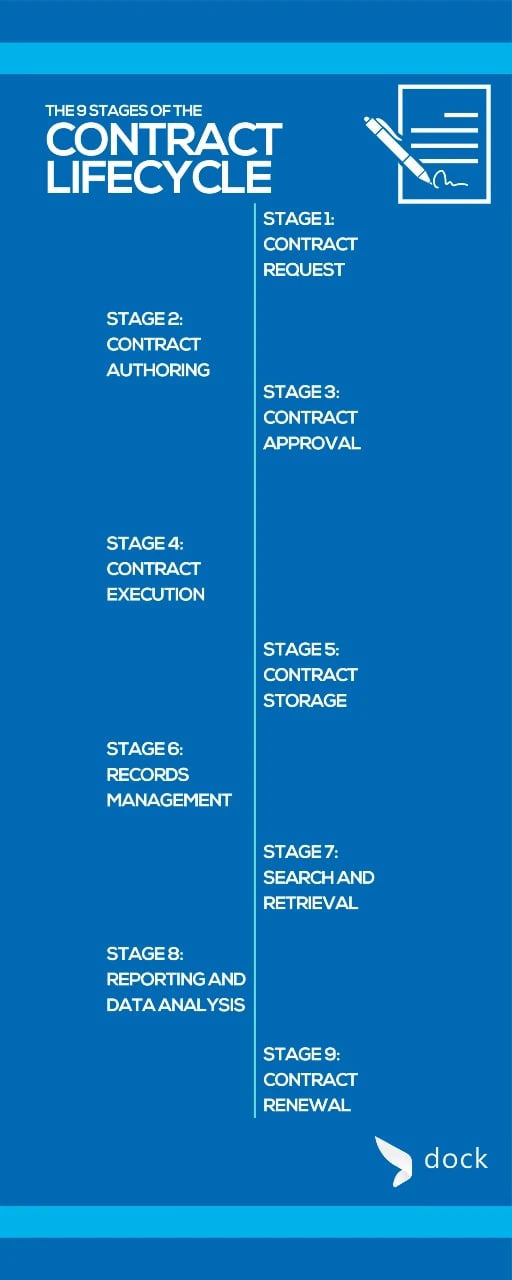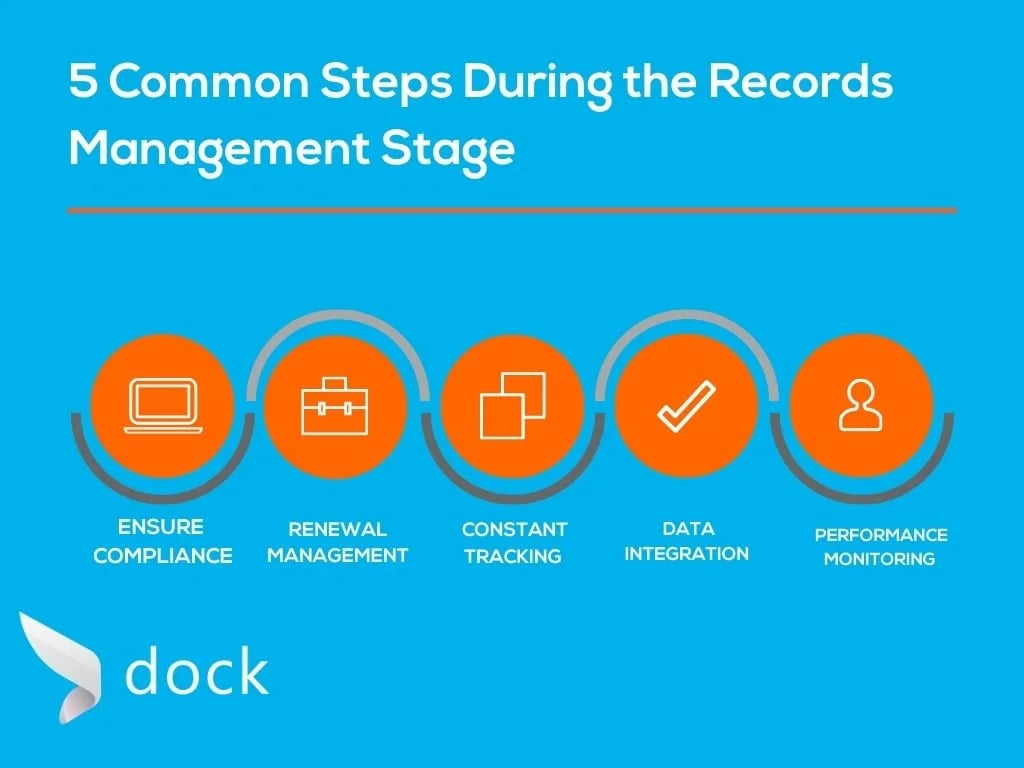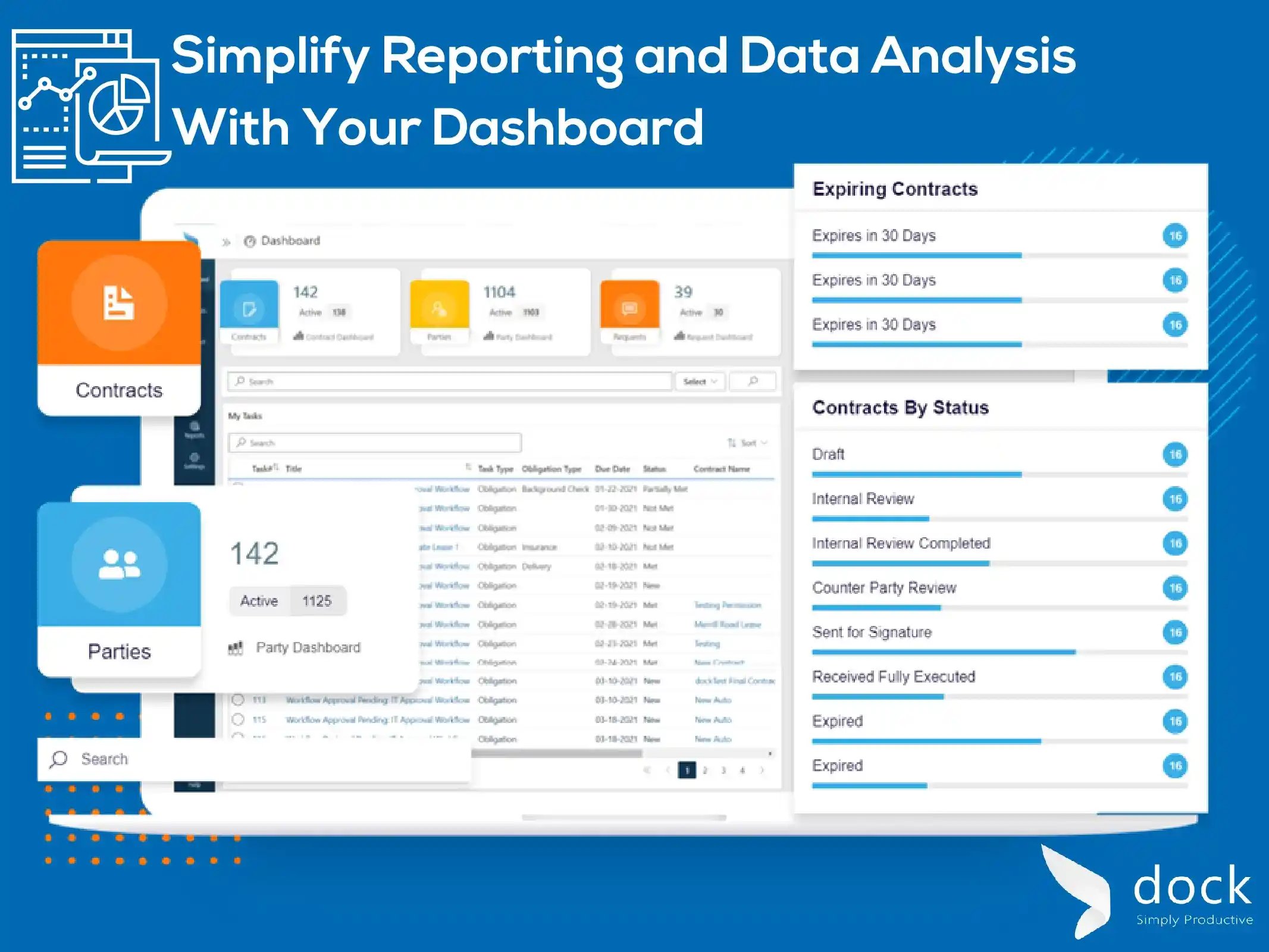
A Basic Guide To Contract Lifecycle Management
Contracts serve several essential purposes within modern businesses and organizations. The tasks and responsibilities required in a contract lifecycle are often mundane and repeatable, making managing contracts not necessarily the most “enchanting” of processes. To this end, you can simplify them with automation and software solutions built to not only take care of but to optimize and streamline these repeatable tasks. Contract lifecycle management software empowers business owners by providing contract control and security. Below, we will take a deep dive into all this and more.
Contents-
- What is Contract Lifecycle Management
- The Need for Contract Lifecycle Management
- 5 Effects of Subpar Contract Lifecycle Management
- 5 Effects of an Optimized Contract Lifecycle Management Solution
- Stages of Contract Lifecycle Management
- Keys to Improve Your Contract Lifecycle Management
- Considerations for Contract Lifecycle Management Software Implementation
- Conclusion
What is Contract Lifecycle Management?
Contract lifecycle management is a system that oversees the progression and performance of contracts throughout their lifecycles, ensuring that compliance is maintained, dates and deliverables are met and that the contract is followed appropriately according to its terms. During the contract lifecycle, you will track various KPIs, contract metrics, and data to glean key insights into how your contract strategies are performing.
An automated contract management system standardizes the completion of tasks with customizable contract workflows, making it easy to complete accurate, efficient approvals, reviews, negotiations, and more. The alternative to contract automation and leveraging contract management software is traditional, manual contract management – inherently prone to increased risks, human errors, and security breaches. To add, your traditional contract management procedures take an exorbitant amount of time. Just consider how long it takes to find a specific contract from a filing cabinet or chain of emails. With contract management software, you can locate exact contracts in seconds with a text-based search.
The Need for Contract Lifecycle Management
It is key to contract efficiency and avoiding many of the bottlenecks and costly repercussions that come as a side effect of subpar contract control. By implementing an intelligent approach and leveraging CLM software, you can gain full control over every stage of every contract. Maximized visibility, transparency, and accountability in all of your organization’s contract management activities play a significant role in your success.
5 Effects of Subpar Contract Lifecycle Management
Contracts are the cornerstone of numerous business partnerships; however, many organizations fail to recognize the importance of prioritizing contract performance and standardization. Even if your business consistently delivers a great product and/or service, you should systematize your contract procedures and implement dedicated strategies to mitigate risks. In many instances, it’s the businesses that overlook the importance of contract efficiency that ends up missing out on potential deals, business partnerships and opportunities, and ways to improve their bottom line.
It's no secret that contracts are important. They’re used in sales processes, hiring, intellectual property rights, legal proceedings, and so much more. Defining the requirements for products and services to be transferred between contracting parties, as well as determining the obligations, conditions, and terms for the agreement, contracts mitigate risks for both sides. The following are the repercussions of ineffective contract management:
1. Unfulfilled Contract Terms
Improper contract management results in failure to deliver upon what was promised in your contracts. Don’t waste the time spent during negotiations by having an ineffective method of contract enforcement!
2. Missed Deadlines
Don’t run the risk of missing key dates and deadlines like contract expiries, auto-renewals, and opt-out windows. Traditional contract management does not centralize your key dates, and you lose the opportunity to configure automated notifications and reminders to keep your team in the loop of upcoming, time-sensitive obligations and dates. Why settle for delivering things past due or for forgetting about key dates and running the risk of financial repercussions when there’s a better way that boosts organizational awareness?
3. Bottlenecks, Bottlenecks, Bottlenecks
A poor contract management system is bound to cause unnecessary delays. From locating contracts within your manual contract storage method to sending and receiving contracts for signature, to data analysis and sharing reports… don’t run the risk of lost time (and remember, time is money!) and take advantage of an automated solution that makes contract management seamless and time-effective.
4. Discrepancies
Mistakes will be made no matter how much you safeguard your contract management procedures. However, an intuitive contract management solution can offer accountability and standardization of contract management practices, reducing the likelihood of manual, human errors. You can easily assess risks, monitor performance and KPI outcomes, configure automated reminders to keep tabs on key dates and leverage contract templates and clause libraries to build compliant, accurate contracts every time.
5. Procrastination and Minimal Proactivity
Don’t let things slip through the cracks when they don’t have to. Poor contract management means you’re often leaving key responsibilities and time-sensitive contract tasks to the last minute, making you even more susceptible to risks and the financial repercussions that come along with the failure to deliver contracts on time. Without a proactive contract management solution, you may end up making the wrong decisions simply because you didn’t allow yourself enough time to prepare. Consider this concept in the context of negotiations and approvals where it’s essential to have enough time to prepare to get the best possible deals. A contract management system can assist you in analyzing ways to cut spending and increase your ROI.
5 Effects of an Optimized Contract Lifecycle Management Solution
The contract management solutions available today empower companies to oversee massive contract portfolios in a manner that is unique to their business needs and objectives. Adopting best practices to streamline the contract lifecycle can enable more results from your contracts. It supports organizations in leveraging better deals and opportunities. There are even services available designed specifically for small business support. All of these factors improve the client and vendor experience to keep them coming back to your organization.
1. Improved Compliance Management
Compliance is an essential component of contract management and maintaining compliant contract practices is made easy with contract management software. In this manner, you can prevent your organization from the financial aftermath associated with non-compliance. Why go through the hassle of litigation when you don’t have to?
2. Cost-Efficiency
Contract management software can support you in reducing your spending in several ways. For one, introducing automation not only reduces the potential for risks and human errors but also can route your contracts on a predesigned workflow – a sequence of people receiving the agreement and taking specific actions on the agreement. The increased visibility provided by proactive dashboards allows you to improve risk mitigation efforts and save money. You’ll also minimize any of the costs associated with security breaches.
3. Reductions in Human Errors
Digitizing and automating your contract management approach can result in major reductions in human errors. Fewer errors mean fewer risks and an improved customer and vendor experience when working with your organization on contracts.
4. Shorter Contract Lifecycles
Contract management software supports time management through the automation of repeatable, low-level tasks. You’ll save time searching for contracts within your digital repository and be able to get your contracts swiftly started on the right foot with customizable contract intake and request forms. Signing is also secure and efficient with electronic signature integrations (i.e., DocuSign, Adobe Sign, Sertifi eSignature, etc.). With all of these factors considered, you will create and execute more professional and accurate contracts in less time.
5. Elimination of Bottlenecks
Optimized contract management means little to no bottlenecks, if ever. By standardizing your contract procedures with software, you can reduce the likelihood of contracts getting stuck in various parts of the contract lifecycle.
Stages of Contract Lifecycle Management
The contract lifecycle involves several stages that are essential to the successful execution of a contract. Contract management software supports the smooth transition of contracts from stage to stage, ensuring they are routed to the right person at the right time. Let’s review the key stages of the contract lifecycle.

1. Contract Intake and Request
In the contract request stage, the potential client submits a request for a contract. Based on the information provided by the potential client (or vendor/supplier) in the contract intake and request form, the information is auto-populated into an appropriate, preapproved contract template. Many contract management solutions offer customizable contract intake forms, where the potential client provides contract information like milestones, term dates, names, contact information, and more.
Following this, a comprehensive audit trail is created, and the new information is securely stored within your system’s digital repository. This allows contract management administrators to use the data as needed by navigating to their contract management dashboard.
2. Contract Authoring
Contract management services offer solutions to all of your contract creation problems. One of which includes the step of contract creation, which traditionally is a bit more complicated. However, the software makes this step fast and simple. They offer preapproved templates and clause libraries.
With the help of a template library, your business can cut down on turnaround times and effectively store and use many templates that make contract management faster from the very beginning. By having a collection of preapproved contract templates, you directly mitigate contractual risk and increase compliance. Additionally, you can enable specific permissions for certain users to access the contract template library within your organization for an extra layer of security.
3. Contract Review & Approval
In the contract review step, you ensure that contracts are designed properly for their specific purpose. During this critical step, contract management software helps organize contracts and notify the appropriate parties to review the document through automated workflows. They ensure that the contract reviews are consistently collaborative, and thorough, and result in compliance before the contract moves onto the approval process.
The contract approval stage is where a contract is approved by specified internal and external approval parties. Certain services available today offer flexible and customizable automated workflows to take the guesswork out of the steps and tasks to be completed for each agreement. This allows you to create efficiency by developing a sequential approach to sending contract drafts off for approvals.
Automated workflows allow you to standardize and create reliability in your procedures. These flows ensure your drafts are sent to the right people at the right times to complete exact tasks. E-signature capabilities eliminate the need for any paper-based processing in the approval workflow. Automatic notification features that come with workflow settings make sure that contracts do not end up in an approver’s inbox unnoticed.
5. Contract Execution
Contract execution refers to the stage of the contract lifecycle where the agreement is signed and initiated. Executing contracts is easier than ever today. With contract management software, you can sign contracts instantly with electronic signatures on any device, no matter where you are geographically. Our contract management system is integrated with DocuSign, Adobe Sign, and Sertifi eSignature solutions, making signature capture seamless.
Electronic signature integrations allow you to send and receive signed contracts securely within seconds without having to print and mail physical copies of your contracts. Within the workflow, after a signature is captured, the signed documents are then uploaded, causing the document to update the data within the centralized contract repository post-execution. This saves parties on both sides of the contract time and money. Once a contract is signed and fully executed, its terms legally bind the parties, activating the contract itself.
6. Records Management
Records management is one of the less commonly discussed stages of the contract lifecycle. During records management, contract managers will continue to oversee every contract, ensuring that terms and obligations are followed and that the contracts maintain secure storage (leveraging features like SharePoint Backup and SharePoint Restore.) Records management is essential to continually monitor the compliance of your contracts and contract procedures. For constant security of your data and to gain confidence in your contracting processes, it’s essential to adopt contract management services that prioritize data security.

7. Search and Retrieval Stage
Ever find yourself wasting hours or even weeks trying to find something specific from your contract storage system? Or have you ever lost a contract due to disjointed storage? Kiss these storage bottlenecks goodbye with a contract management system. During the seventh stage of the contract lifecycle, your company’s contract administrator and other involved departments will locate and retrieve digital contracts and related documents from their contract management software system.
This stage of the contract lifecycle refers to how your organization finds contracts, clauses, associated documents, and key terms within its digital repository. By optimizing your organization’s contract search and retrieval stage, you increase the ease of contract accessibility. In addition to enhancing contract accessibility, you’ll improve your business decision-making strategy because you’ll have all the contract answers at your fingertips. In your cloud-secure environment, equipped with permissions-based access features, text search, and custom filters, you’ll ensure that your contracts never go amiss ever again!
8. Reporting and Data Analysis
This stage of the contract lifecycle focuses primarily on the effective retrieval of digital contract data to develop in-depth contract reports. Data is additionally analyzed to aid in decision-making, risk mitigation, and contract optimization. Reporting and data analysis is key to learning where your current practices could use some optimization. Build and share custom reports based on your contract data to keep all stakeholders in the know. With effective data analysis, you can better risk manage and make data-driven contract decisions.
Contract management software systems provide custom reporting and data analytics capabilities so that you can gain valuable insights into each stage of every digital contract’s lifecycle. With detailed and user-friendly data analysis features always available, you can view the duration of digital contract lifecycles, savings, renewal statistics, sales metrics, and other data points about the effectiveness of your contract management processes. The continued analysis of the contract gives time for teams to manage contract renewals and terminations smoothly.
9. Contract Performance
Use post-execution contract management to your advantage by assessing contract lifecycle performance with intuitive data dashboards. Overseeing contract performance means consistently evaluating the actions being taken according to the expectations for the contract. Other items pertaining to monitoring performance include minoring expenses and compliance. You can keep tabs on several key points of data, including factors relating to legal, financial, procurement, sales, and more. Ensure that contract speed and cycle times are performing to standard, that risks are being managed properly, and that renewals and expiration dates are accounted for on time.
In this manner, you’ll have instant access to the numbers that prove the effectiveness of your current contract management practices. Continued performance analysis enhances the efficiency of your contract lifecycle management system. It helps to keep your solution proactive and transparent to all parties involved.
10. Contract Expiration or Renewal
And finally! Contract renewal. Contract expiration and renewal are the final destinations in the contract lifecycle. Effective contract management services provide alerts, notifications, and reminders regarding the most important dates and milestones that occur within a contract’s lifecycle. With your software, you can keep tabs on all key dates and design automated reminders to be sent off to your team so that renewals and expirations don’t pass you by.
This means you’ll have enough time to prepare for the best deals, as well as determine whether or not to retain an auto-renewal for another term. Knowing when contracts renew and expire is crucial, as some contracts might contain autorenewal clauses that can financially impact your business. The last thing you want to have an unfavorable contract with an auto-renewal clause continue for yet another term and waste your time and money. Automated alerts of upcoming expiries will help your team remember to start reviewing contracts so they can make the right decision on how to proceed.
Keys to Improve Your Contract Lifecycle Management
The number one way to take your business’s contract management to the next level is by adopting a contract management software solution. According to World Commerce and Contracting, companies that adopt a contract management system can experience up to a 9% improvement in revenue annually.
Now, let’s take a look at the ways how automated software can help.
Use a cloud-secure centralized repository to keep all of your contracts and associated documents in a single location, accessible only to authorized users around the clock. Your repository makes it remarkably easy to securely manage, store, and retrieve contracts at the times you need them most. No need to stress about losing contracts in filing cabinets or shared drives – your digital repository keeps everything safe in one spot. This means you’ll cut down on contract misplacement, tampering, and data loss. We suggest leveraging a SharePoint-based contract repository.
-
Accurate Contract Authoring with Template and Clause Libraries
Having a library full of preapproved clauses and compliant contract templates makes it easy to build professional, accurate contracts with speed. This helps to create a secure, risk-preventative approach to building your company’s contracts while maintaining swift, productive processes.
-
Automate Processes with Contract Workflows
Automation is perhaps one of the greatest benefits that contract management software has to offer. You can build flexible automated contract workflows to route and standardize every action and step a contract travels down. Automated workflows can be used for a single contract or entire groups of contract types. You can also use them for clauses.
-
Configure Reminders of Upcoming Auto Renewals and Expirations
Contract lifecycle management improves organizational awareness and visibility into upcoming key dates and obligations. Automated reminders are one of the most underrated, yet highly risk-mitigative features of modern software. Now you can prepare ahead for your negotiations, reviews, and expirations, as your software will notify users when specific actions need to be taken.
-
Integrate with Electronic Signatures
Electronic signatures have revolutionized modern contract management. Now, you can sign and execute contracts within seconds at your convenience on your mobile device at any time, any place. This saves paper, time, and money while increasing the security of your signing procedures.
-
Create and Share Custom Reports
Reporting is key to maintaining clear communication with stakeholders and employees regarding the performance, status, and progress of your contracts. Manual contract tracking makes it more complicated than it has to be to pull contract data and generate reports. However, the software makes this efficient and easy so that you can swiftly make the most data-driven business decisions.

-
Use Advanced Search and Savable Filters
Search through mountains of metadata with advanced text-based search capabilities and customizable filters that you can save for repeated use on common contract types. You’ll save a massive amount of time by simply making it easier to locate what you need.
-
Optimize Contract Intake and Requests with Custom Forms
The contract intake and request step of the contract lifecycle sets the stage for what’s to come during the remainder of the contract’s lifecycle. Contract management software allows users to standardize their contract intake stage with customizable contract intake forms that capture client information to assist in rapid contract drafting by auto-populating contract template data fields with the information provided in the request form. Traditionally, this step was completed via email communication, making for an inefficient and risk-prone start to each contract.
-
Monitor Contract Statuses and Performance with Dashboards
Digital contract management dashboards provide a comprehensive picture of the status and performance of your company’s contracts. With contract management software, you can make data analysis a strength rather than a pain point because you’ll have constant access to current contract data. Review contract lifecycles with all the data you could ask for, allowing you to identify where optimization needs to be introduced for improved processes.
-
Use Version Control
Ensure your teams are only working on the most current documents with version control. In your software platform, all changes to all of your drafts are documented and stored for you to review at any time. You can easily find out who made which additions, edits, or deletions to any document and at which time. Version control provides an extra layer of risk mitigation to your contract management strategy, as it can help protect against duplicates or loss of contract drafts and metadata.
Considerations for Contract Lifecycle Management Software Implementation
Planning to use a new CLM software solution and unsure how to prepare? Let’s discuss some key things to keep in mind when implementing a new solution.
Finding the right contract management system appropriately suited for your organization’s objectives and needs can certainly prove to be a challenging process, but the implementation of the new solution presents a whole new set of obstacles. Regardless of the size of your business and the volume of your contract portfolio, implementation can be a source of stress and strain if you fail to prepare for it. Comprehensive training on the new system and an adaptive, user-friendly system interface are central to a smooth, swift implementation phase as opposed to a lengthy, unproductive one.
Now, let’s dive into some important things to consider before implementing your new solution.
1. Have a plan
Before you adopt your new software, you should have a workable plan in place to streamline your system implementation. Here are some things that you should plan for:
- the roll-out date of the system
- the size of your contract storage system
- which user permissions will need configuration
- how do you organize contract data
- ensure each department will have access to the new solution
Once you’ve considered these concepts, we recommend communicating with your team and making a comprehensive system implementation plan.
2. Ensure the solution you choose is user-friendly
For a smooth, hassle-free adoption phase, you’ll want to confirm that the system itself is simple and easy to work with. The smaller the feature set of the solution, the less time you will have to spend training your team on the solution. We suggest giving this a read so you know which key features to keep an eye out for when selecting a software platform. Why force your team to maneuver through a new system with a massive feature set when you could choose a solution with only the features you’ll need?
3. Provide sufficient training for your team on the new solution
This is perhaps the most important part of the implementation phase of your new contract management software. Give your team enough time dedicated to learning how to use the new system properly so they confidently get started. With productive system training sessions, you support employee adoption of the solution. And according to how large your organization is, you might need to strategize your training. Virtual, interactive training through online meeting spaces and webinars can be an excellent way to teach your to teams how to use the system. With a greater understanding of how the software works organization-wide, comes a greater level of not only success but also compliance in your contract lifecycle.
4. Stay in communication with your software provider for guidance, questions, and troubleshooting
Transitioning your sensitive contract data from one platform to another can be stressful. Whether it’s from one digital solution to another, or from physical contract copies and manual storage, moving data from one place to another can be a taxing process. Stay in touch with the software provider to support you through implementation. Instead of leaning on your internal teams for support, and wasting your own company’s resources during adoption, you should instead rely on the provider. They likely offer complimentary user support. During implementation, your teams will likely need support in some capacity when learning how to use the solution throughout all phases of the contract lifecycle. Make sure that your team has access to the contact information of the software provider so they can get in touch and receive assistance at their convenience.
5. Determine how you will transfer data from one system to another
Oftentimes, businesses start software implementation by gathering contracts and associated data and sending it all to the new software provider. Before being introduced to the new solution, contracts must be processed appropriately.
6. Analyze your current approach to contract lifecycle management.
Are your contracts currently meeting expectations and goals? Based on the current performance of your contract portfolio, identify which parts of your contract lifecycle could use improvement. Where are bottlenecks present? Does signing and approval take longer than necessary? Develop an awareness regarding the pain points of your current strategy so you can make proactive changes as you optimize and improve your contract management. From here, you can create new KPIs based on the results of your contract performance analysis.
7. Implement the new solution in phases
When compared to a pilot approach (a small-scale implementation), a phased implementation strategy is one of the more time and cost-efficient options that we recommend you use. A phased software implementation results in a quicker start to using your new software. And what does this ultimately mean? You can get started sooner working with your vendors, suppliers, and customers on the new platform. We recommend creating a detailed, time-blocked schedule inclusive of deadlines for your implementation phase so that your whole team is guaranteed to have learned how to use the solution properly by an exact date.
8. Prioritize clear communication and confirm understanding of the new solution
Keep risks minimal by confirming that everyone has a firm grasp on how to use the new solution. Go team by team, from procurement and legal to sales and HR, to finance and operations, ensuring everyone understands how to use the solution. Without clear and effective communication, you run the risk of contracts slipping through the cracks due to improper training and insufficient understanding of the solution across your teams. When communication is optimal, you’ll see massive improvements in workplace productivity and business optimization.
9. Specify roles and responsibilities
During the roll-out of your new contract lifecycle management software, you’ll want to allocate certain tasks evenly to select reliable team members. Develop an implementation team that is dedicated to a fruitful implementation of the solution and its success in the long term. We suggest that you assign a small team of individuals to carry out responsibilities related to the implementation. This team will assist other employees, training them on the solution and providing clarification and troubleshooting help after the system is adopted.
Involve senior management as well so that expectations and objectives are understood throughout the chain of command. Your leadership team can support the transition to the new solution by appropriately designating tasks and roles. They can also help with decision-making when using the new features provided by the system to support business results. With your dedicated CLM implementation support team, you can have a combination of unique expertise and experiences from their work in various departments that will allow for an organized and comprehensive implementation.
Conclusion
The contract lifecycle is an intricate process involving several steps, stages, actions, tasks, and people. Whether your approach to contract management sinks or swims is solely dependent on the systems you have in place for efficiency and risk mitigation. Whether you need support in system implementation, or in optimizing a specific phase, the contract management lifecycle itself is a process that requires constant refining to ensure that your system works properly and that your contracts are executed accurately.
We hope you learned some helpful information regarding what a successful contract lifecycle management software implementation phase looks like, what the stages in the contract lifecycle are, and how you can optimize your current contract management procedures.

Written by Quentin Russell
Quentin Russell is a Content Specialist with knowledge of Content Marketing and Social Media Marketing.
Reviewed by Naveen K P
Book a Live demo
Schedule a live demo of Dock 365's Contract Management Software instantly.




